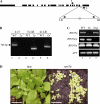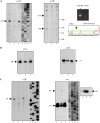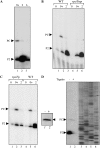Phage-type RNA polymerase RPOTmp transcribes the rrn operon from the PC promoter at early developmental stages in Arabidopsis
- PMID: 17885088
- PMCID: PMC2048797
- DOI: 10.1104/pp.107.103846
Phage-type RNA polymerase RPOTmp transcribes the rrn operon from the PC promoter at early developmental stages in Arabidopsis
Abstract
The plastid genome of higher plants is transcribed by two different types of RNA polymerases named nucleus encoded RNA polymerase (NEP) and plastid encoded RNA polymerase. Plastid encoded RNA polymerase is a multimeric enzyme comparable to eubacterial RNA polymerases. NEP enzymes represent a small family of monomeric phage-type RNA polymerases. Dicotyledonous plants harbor three different phage-type enzymes, named RPOTm, RPOTp, and RPOTmp. RPOTm is exclusively targeted to mitochondria, RPOTp is exclusively targeted to plastids, and RPOTmp is targeted to plastids as well as to mitochondria. In this article, we have made use of RPOTp and RPOTmp T-DNA insertion mutants to answer the question of whether both plastid-located phage-type RNA polymerases have overlapping or specific functions in plastid transcription. To this aim, we have analyzed accD and rpoB messenger RNAs (mRNA; transcribed from type I NEP promoters), clpP mRNA (transcribed from the -59 type II NEP promoter), and the 16S rRNA (transcribed from the exceptional PC NEP promoter) by primer extension. Results suggest that RPOTp represents the principal RNA polymerase for transcribing NEP-controlled mRNA genes during early plant development, while RPOTmp transcribes specifically the rrn operon from the PC promoter during seed imbibition.
Figures





Similar articles
-
Impaired function of the phage-type RNA polymerase RpoTp in transcription of chloroplast genes is compensated by a second phage-type RNA polymerase.Nucleic Acids Res. 2008 Feb;36(3):785-92. doi: 10.1093/nar/gkm1111. Epub 2007 Dec 15. Nucleic Acids Res. 2008. PMID: 18084023 Free PMC article.
-
Development- and tissue-specific expression of the RpoT gene family of Arabidopsis encoding mitochondrial and plastid RNA polymerases.Planta. 2006 Apr;223(5):998-1009. doi: 10.1007/s00425-005-0159-y. Epub 2005 Nov 24. Planta. 2006. PMID: 16307282
-
In vitro promoter recognition by the catalytic subunit of plant phage-type RNA polymerases.Plant Mol Biol. 2016 Oct;92(3):357-69. doi: 10.1007/s11103-016-0518-z. Epub 2016 Aug 6. Plant Mol Biol. 2016. PMID: 27497992 Free PMC article.
-
Chloroplast RNA polymerases: Role in chloroplast biogenesis.Biochim Biophys Acta. 2015 Sep;1847(9):761-9. doi: 10.1016/j.bbabio.2015.02.004. Epub 2015 Feb 11. Biochim Biophys Acta. 2015. PMID: 25680513 Review.
-
The plastid transcription machinery and its coordination with the expression of nuclear genome: Plastid-Encoded Polymerase, Nuclear-Encoded Polymerase and the Genomes Uncoupled 1-mediated retrograde communication.Philos Trans R Soc Lond B Biol Sci. 2020 Jun 22;375(1801):20190399. doi: 10.1098/rstb.2019.0399. Epub 2020 May 4. Philos Trans R Soc Lond B Biol Sci. 2020. PMID: 32362266 Free PMC article. Review.
Cited by
-
Complex chloroplast RNA metabolism: just debugging the genetic programme?BMC Biol. 2008 Aug 28;6:36. doi: 10.1186/1741-7007-6-36. BMC Biol. 2008. PMID: 18755031 Free PMC article.
-
RHON1 mediates a Rho-like activity for transcription termination in plastids of Arabidopsis thaliana.Plant Cell. 2014 Dec;26(12):4918-32. doi: 10.1105/tpc.114.132118. Epub 2014 Dec 5. Plant Cell. 2014. PMID: 25480370 Free PMC article.
-
The caseinolytic protease complex component CLPC1 in Arabidopsis maintains proteome and RNA homeostasis in chloroplasts.BMC Plant Biol. 2018 Sep 12;18(1):192. doi: 10.1186/s12870-018-1396-0. BMC Plant Biol. 2018. PMID: 30208840 Free PMC article.
-
Phytohormones as Regulators of Mitochondrial Gene Expression in Arabidopsis thaliana.Int J Mol Sci. 2023 Nov 29;24(23):16924. doi: 10.3390/ijms242316924. Int J Mol Sci. 2023. PMID: 38069246 Free PMC article.
-
Comparative analysis of plastid genomes of non-photosynthetic Ericaceae and their photosynthetic relatives.Sci Rep. 2016 Jul 25;6:30042. doi: 10.1038/srep30042. Sci Rep. 2016. PMID: 27452401 Free PMC article.
References
-
- Allison LA (2000) The role of sigma factors in plastid transcription. Biochimie 82 537–548 - PubMed
-
- Baba K, Schmidt J, Espinosa-Ruiz A, Villarejo A, Gardeström P, Sane AP, Bhalerao P (2004) Organellar gene transcription and early seedling development are affected in the rpoT;2 mutant of Arabidopsis. Plant J 38 38–48 - PubMed
Publication types
MeSH terms
Substances
LinkOut - more resources
Full Text Sources
Molecular Biology Databases

